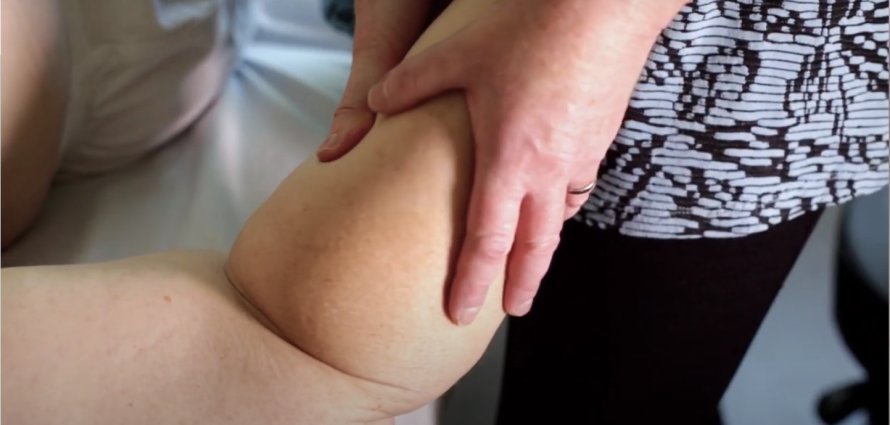Lymphedema
The early detection and treatment of lymphedema can help to improve or manage the condition and prevent it from progressing to an advanced stage.

At Breast Rehab all of our therapists are certified to treat lymphedema. We help clients with lymphedema manage their condition and prevent it from progressing. We also work with clients who have breast cancer to help reduce their risk of developing secondary lymphedema. We offer a pre-op assessment as part of our pre-rehab physio to help monitor for secondary lymphedema. We also recommend that people who have had lymph nodes removed or damaged watch out for early signs of lymphedema.
What is lymphedema?
Lymphedema is a buildup of lymphatic fluid that leads to tissue swelling, most commonly in the hands/arms, chest, feet/legs, or trunk of the body. It is a chronic, lifelong condition that cannot be cured but can be managed. Some breast cancer patients have an increased chance of developing lymphedema in the arm and hand through removal of lymph nodes from the armpit or from damage to the lymph nodes from radiation therapy.
About the lymphatic system
The lymphatic system is an important part of your immune system, helping to remove toxins from your body and fight infection. It is made up of a complex network of lymph vessels, lymph nodes, and lymph tissue throughout the body, with clusters of lymph nodes in the neck, head, armpits, groin, and stomach. Lymph fluid transports toxins to the lymph nodes, where they are filtered and removed. White blood cells are also transported in the lymph fluid, to help the body fight infection.
Causes of lymphedema
There are two types of lymphedema: primary and secondary (or acquired) lymphedema. Secondary is more common than primary lymphedema. Primary lymphedema is usually genetic and occurs in people who are born with a faulty lymphatic system. Secondary lymphedema is acquired by people whose lymph nodes or vessels have been damaged as a result of vascular disease, surgery, injury/trauma, or treatment for some cancers (including breast, ovarian, colon, prostate and others). The leading causes of secondary lymphedema are lymph node removal and radiation therapy. Lymphedema can come on gradually or suddenly, sometimes many years after treatment for cancer.
Signs of lymphedema
- A new feeling of tightness in the skin
- A sense of fullness, heaviness or discomfort in an arm, chest, leg, or other area
- Clothing or jewellery feeling tighter than usual on an arm, chest, leg, or other area
- A new onset of numbness or tingling
- Visible swelling
Finding lymphedema early
The early detection and treatment of lymphedema can help to improve or manage the condition and prevent it from progressing to an advanced stage. When it is detected early, lymphedema treatment is far less complex and costly than when the condition has progressed. Lower rates of secondary lymphedema have been found in people who exercise regularly and seek the advice of a lymphedema-certified physiotherapist.
Treating lymphedema
Lymphedema is treated with a combination of therapies and self-care approaches.
Therapies
- Manual lymphatic drainage massage by a certified lymphedema therapist
- Compression therapy using garments or bandaging
- Laser therapy (if appropriate)
Manual lymphatic drainage is a special type of massage that is designed to promote the movement of lymph fluid. All of Breast Rehab’s therapists are trained in manual lymphatic drainage. We also have staff who are specialized in compression therapy and laser therapy.
Self-care practices
- Practicing good skin care
- Regular moderate exercise
The purpose of good skin care is to reduce the risk of infection. Ways to achieve this include:
- Careful nail and cuticle hygiene to prevent entry points for infection
- Applying antibiotic cream straight away to small cuts or skin abrasions
- Using a skin moisturizer
- Wearing gloves to garden or clean the house
- If possible, having bloodwork, injections, and blood pressure monitoring on the other side from where your cancer was treated
Redness of the skin, swelling or heat in the affected area could be a sign of infection. If you notice this, please call your doctor or seek medical help right away.
Regular moderate exercise is also an important part of lymphedema management. During exercise, deep breathing and the contraction of your muscles help to stimulate the flow of lymphatic fluid. Exercise to manage lymphedema is a balance between stimulating lymphatic flow and not overloading the body with excess fluid. Our therapists can work with you to achieve this balance. Regular exercise can also help you achieve a healthy body weight, improve your flexibility, and boost your overall well-being and quality of life.
You can print out our Lymphedema Management Sheet for details on how to detect lymphedema and how to reduce your risk.
Our goal is for you to get back to doing the things you love, with the best quality of life possible and our lymphedema-certified therapists can help you manage your condition.

